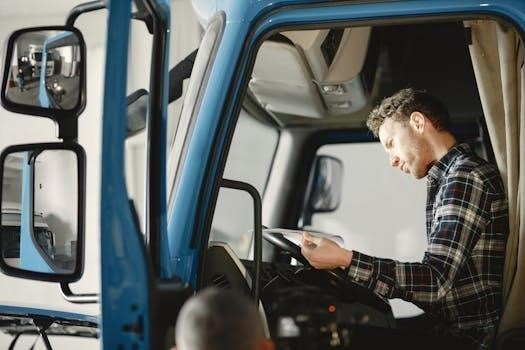
Oregon Commercial Driver’s License (CDL) Manual
Preparing for your Oregon Commercial Driver’s License? The Oregon CDL manual, officially known as Form 735-36, is your essential study guide. It covers vital information for DMV exams, including written and road skills tests. Access the online version, always updated, or obtain a physical copy.

Welcome to the gateway to your commercial driving career in Oregon! The Oregon Commercial Driver’s License (CDL) Manual is more than just a document; it’s your comprehensive guide to understanding the rules, regulations, and safe practices necessary for operating commercial motor vehicles (CMVs) within the state. Think of it as your textbook for the road, filled with essential information that will help you pass your CDL exams and, more importantly, become a safe and responsible professional driver.
This manual is meticulously crafted by the Oregon Department of Transportation (ODOT) and updated regularly to reflect the latest changes in federal and state laws. It’s designed to introduce aspiring commercial drivers to the fundamentals of commercial trucking, covering everything from basic vehicle control to advanced topics like hazardous materials transportation. Whether you’re a seasoned driver looking to add an endorsement or a newcomer eager to start a trucking career, this manual is your starting point.
Inside, you’ll find detailed explanations, clear diagrams, and practical advice to help you master the knowledge and skills required to operate a CMV safely and efficiently. So, buckle up and get ready to embark on your journey towards earning your Oregon CDL!
Purpose of the Manual
The Oregon Commercial Driver’s License (CDL) Manual serves as the definitive resource for individuals seeking to obtain a CDL or Commercial Learner’s Permit (CLP) in Oregon. Its primary purpose is to equip aspiring commercial drivers with the knowledge and skills necessary to operate commercial motor vehicles (CMVs) safely and in compliance with all applicable federal and state regulations.
Specifically, the manual aims to prepare drivers for the CDL knowledge and skills tests administered by the Oregon Department of Motor Vehicles (DMV). It covers a wide range of topics, including general knowledge requirements, safe operation of CMVs, vehicle inspection procedures, basic vehicle control skills, and endorsements such as hazardous materials (Hazmat) and passenger transport.
Beyond test preparation, the manual promotes safe driving practices and fosters a culture of responsibility among commercial drivers. It emphasizes the importance of understanding vehicle systems, recognizing potential hazards, and making sound decisions behind the wheel. By providing comprehensive information and practical guidance, the Oregon CDL Manual contributes to the safety of Oregon’s roadways and the professionalism of its commercial driving workforce; Ultimately, the goal is to ensure that all licensed commercial drivers possess the competence and awareness needed to operate CMVs safely and responsibly.
Where to Obtain the Manual
Acquiring the Oregon Commercial Driver’s License (CDL) Manual is a straightforward process, with several convenient options available to prospective commercial drivers. The most readily accessible method is through the Oregon Department of Motor Vehicles (DMV) website. The DMV provides a digital version of the manual, ensuring that you always have access to the most up-to-date information.
For those who prefer a physical copy, the Oregon CDL Manual can be obtained directly from any Oregon DMV location. This allows for offline study and is particularly useful for individuals who prefer reading a printed document. It’s advisable to call ahead to your local DMV office to confirm availability before making a trip.
Additionally, some third-party vendors, such as online retailers and bookstores, may offer printed versions of the Oregon CDL Manual for purchase. However, it’s essential to verify that these versions are current and officially recognized by the Oregon DMV to ensure accurate and reliable information. Utilizing the official Oregon DMV website or visiting a local DMV office remains the most reliable method for obtaining the most current and accurate manual.
Oregon CDL Manual Sections Overview
The Oregon CDL Manual is meticulously structured into thirteen key sections, each designed to equip aspiring commercial drivers with the knowledge and skills necessary for safe and responsible operation. These sections cover a broad spectrum of topics, ranging from the fundamentals of commercial vehicle operation to specialized endorsements and regulations.
The manual begins with general knowledge requirements, establishing a foundation of essential information for all CDL applicants. Subsequent sections delve into safe operating practices, emphasizing techniques for maintaining control, managing space, and responding to hazards. Vehicle inspection procedures are covered in detail, ensuring drivers can identify and address potential mechanical issues before they lead to accidents.
Further sections address specialized topics such as combination vehicles, air brake systems, and hazardous materials (Hazmat) endorsements. These sections provide in-depth knowledge for drivers operating specific types of vehicles or transporting regulated materials. Finally, the manual includes guidance on CDL skills test preparation, offering valuable tips and strategies for successfully completing the practical examination. This comprehensive structure allows candidates to systematically study and master the necessary information for obtaining their Oregon CDL.
General Knowledge Requirements
The General Knowledge section of the Oregon CDL Manual lays the groundwork for all aspiring commercial drivers, irrespective of the specific class of license or endorsements they seek. This section encompasses fundamental principles and regulations that every driver must understand to operate a commercial vehicle safely and legally on Oregon roads.
Key topics covered include basic traffic laws, rules of the road, and safe driving practices applicable to all vehicles, with a particular emphasis on the unique challenges and responsibilities associated with operating large commercial vehicles. Drivers will learn about important concepts such as speed management, space management, hazard perception, and defensive driving techniques.
Furthermore, this section delves into crucial aspects of vehicle maintenance and inspection, enabling drivers to identify potential mechanical issues that could compromise safety. It also covers regulations related to driver qualifications, hours of service, and alcohol and drug testing. A thorough understanding of these general knowledge requirements is essential for passing the CDL knowledge test and for ensuring safe and responsible operation throughout a commercial driving career in Oregon. This knowledge is the bedrock upon which all further specialized training is built.
Safe Operation of Commercial Vehicles
The “Safe Operation of Commercial Vehicles” section within the Oregon CDL Manual is paramount for equipping drivers with the knowledge and skills necessary to prevent accidents and ensure the well-being of themselves and others on the road. This section goes beyond basic driving principles and delves into the specific challenges posed by operating large, heavy commercial vehicles.
It emphasizes the importance of pre-trip inspections to identify potential mechanical issues, proper cargo securement to prevent shifting loads, and techniques for managing speed and space in various driving conditions. Drivers will learn about the dangers of distracted driving, fatigue, and impaired driving, as well as strategies for mitigating these risks. The section also covers defensive driving techniques, such as anticipating potential hazards and reacting appropriately to changing road conditions.
Furthermore, it addresses the unique handling characteristics of commercial vehicles, including their longer stopping distances, wider turning radii, and susceptibility to rollovers. Mastering these concepts is crucial for safe and responsible commercial vehicle operation in Oregon, contributing to a reduction in accidents and improved overall road safety for everyone.
Vehicle Inspection Procedures
The “Vehicle Inspection Procedures” section of the Oregon CDL Manual meticulously outlines the essential steps for conducting thorough pre-trip, en-route, and post-trip inspections. These inspections are vital for identifying potential safety hazards and ensuring the vehicle is in optimal operating condition, contributing significantly to accident prevention.
The manual provides detailed checklists and guidelines for inspecting critical components, including brakes, tires, lights, steering, suspension, and coupling devices. Drivers learn how to identify signs of wear, damage, or malfunction, and understand the importance of reporting and addressing these issues promptly. The section emphasizes the legal requirements for vehicle inspections and the potential consequences of operating a vehicle with safety defects.
Furthermore, it covers the proper documentation of inspections, including completing inspection reports and maintaining accurate records. Mastering these procedures is crucial for CDL holders in Oregon, as it demonstrates their commitment to safety and compliance with regulations. Regular and diligent vehicle inspections are a cornerstone of responsible commercial vehicle operation, safeguarding both the driver and the public.
Basic Vehicle Control Skills
The “Basic Vehicle Control Skills” section of the Oregon CDL Manual is dedicated to mastering the fundamental techniques required to safely operate a commercial motor vehicle. This section emphasizes smooth and precise control over the vehicle in various driving conditions, essential for both safety and efficiency.

Drivers will learn the proper techniques for starting, stopping, and maneuvering the vehicle, including straight-line driving, turning, and backing. The manual provides detailed guidance on steering control, emphasizing the importance of maintaining a firm grip and anticipating changes in direction. It also covers the nuances of shifting gears smoothly and efficiently, crucial for maintaining momentum and fuel economy.
Furthermore, this section addresses the challenges of controlling a large vehicle in adverse weather conditions, such as rain, snow, and ice. Drivers learn how to adjust their speed and steering to maintain control and avoid skidding. The manual also emphasizes the importance of maintaining adequate following distance and anticipating the actions of other drivers.
Mastering these basic vehicle control skills is paramount for any aspiring CDL holder in Oregon, forming the foundation for safe and responsible commercial driving.
Hazardous Materials (Hazmat) Endorsement
The Hazardous Materials (Hazmat) Endorsement section within the Oregon CDL Manual is crucial for drivers intending to transport hazardous materials. This section provides comprehensive information on the regulations, procedures, and safety precautions necessary for handling and transporting such materials safely and legally.

The manual outlines the different classes of hazardous materials, each with its unique risks and handling requirements. Drivers will learn how to identify hazardous materials using placards, labels, and shipping papers, ensuring they are aware of the specific dangers associated with each load.
This section also covers the essential aspects of packaging, loading, and unloading hazardous materials, emphasizing the importance of following strict protocols to prevent spills, leaks, or other accidents. Drivers will learn about emergency response procedures in case of an incident involving hazardous materials, including how to contain spills, evacuate the area, and contact the appropriate authorities.
Furthermore, the manual details the security requirements for transporting hazardous materials, including background checks, security plans, and awareness training. Obtaining the Hazmat Endorsement requires passing a specialized knowledge test, demonstrating a thorough understanding of these regulations and procedures, ensuring public safety and environmental protection.
Combination Vehicles Information
The “Combination Vehicles” section of the Oregon CDL Manual is dedicated to providing drivers with the knowledge and skills necessary to safely operate vehicles with multiple units, such as tractor-trailers and doubles/triples. This section delves into the unique challenges and considerations associated with handling these longer, heavier vehicles.
It covers critical aspects like coupling and uncoupling procedures, emphasizing the importance of proper connections to ensure stability and prevent accidents. Drivers will learn about inspecting coupling devices, air and electrical lines, and the overall integrity of the connection before each trip.
This section also addresses the dynamics of combination vehicles, including off-tracking (the difference in path between the tractor and trailer during turns) and rollover risks. It explains techniques for managing these risks, such as adjusting speed, using proper braking techniques, and understanding load distribution.
Furthermore, the manual details the specific regulations and requirements for operating combination vehicles in Oregon, including length restrictions, weight limits, and bridge formulas. It also covers specialized maneuvers like backing and turning, providing guidance on how to execute these maneuvers safely and efficiently. This section prepares drivers to handle the complexities of combination vehicles, ensuring safer roads for everyone.
Air Brakes Systems
The “Air Brakes Systems” section of the Oregon CDL Manual provides a comprehensive overview of the principles, components, and safe operation of air brake systems commonly found in commercial vehicles. It emphasizes the importance of understanding how these systems work to ensure safe driving practices and prevent accidents.
This section covers the fundamental concepts of air brake operation, including how air pressure is generated, stored, and used to apply the brakes. It explains the different types of air brake systems, such as dual air brake systems, and their specific functions. Drivers will learn about the various components of the system, including the air compressor, reservoirs, brake chambers, and control valves.
The manual details the importance of regular inspections and maintenance of air brake systems. It outlines the steps involved in performing a pre-trip inspection, including checking air pressure levels, inspecting brake lines and hoses, and testing the functionality of the brakes. Drivers will learn how to identify potential problems, such as air leaks, worn brake linings, and malfunctioning valves.
Furthermore, this section provides guidance on proper braking techniques, including how to use the brakes effectively in different driving conditions. It also covers emergency braking procedures and the importance of avoiding brake fade. By understanding the intricacies of air brake systems, drivers can operate commercial vehicles safely and confidently.
CDL Skills Test Preparation
The “CDL Skills Test Preparation” section of the Oregon CDL Manual is designed to equip aspiring commercial drivers with the knowledge and skills necessary to successfully pass the practical portion of the CDL exam. This section focuses on the specific maneuvers and procedures that will be evaluated during the test, providing detailed instructions and tips for mastering each element.
This section covers essential pre-trip inspection procedures, emphasizing the importance of thoroughly inspecting the vehicle for any safety defects before operation. It details the specific items that must be checked, such as tires, brakes, lights, and fluid levels. Drivers will learn how to identify potential problems and take corrective action to ensure the vehicle is safe to operate.
The manual provides step-by-step instructions on performing basic vehicle control skills, including straight-line backing, alley docking, and offset maneuvers. It offers guidance on proper steering techniques, clutch control, and speed management. Drivers will learn how to execute these maneuvers smoothly and accurately, demonstrating their ability to control the vehicle in a safe and efficient manner.
Furthermore, this section covers on-road driving skills, such as merging, lane changes, and turns. It emphasizes the importance of maintaining proper speed and following distance, as well as using mirrors and signals effectively. By mastering these skills, drivers can demonstrate their ability to operate a commercial vehicle safely and responsibly on public roads.



